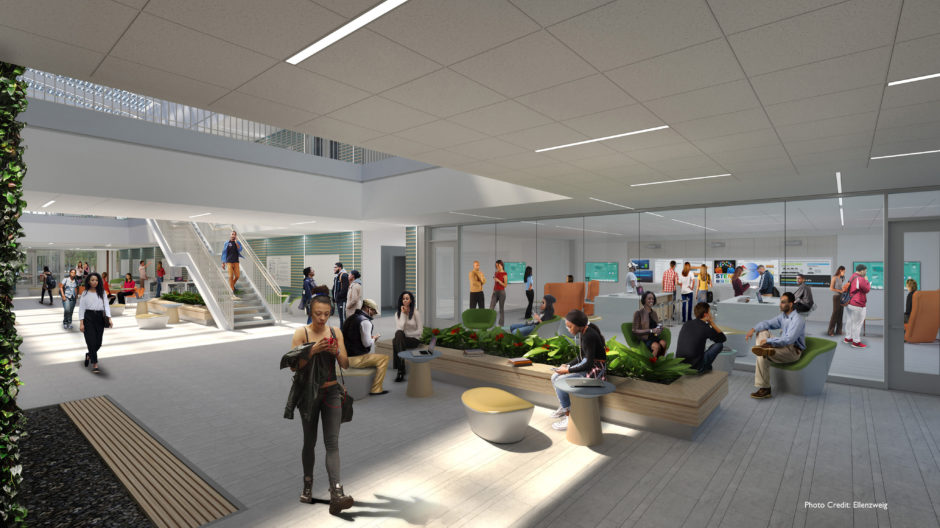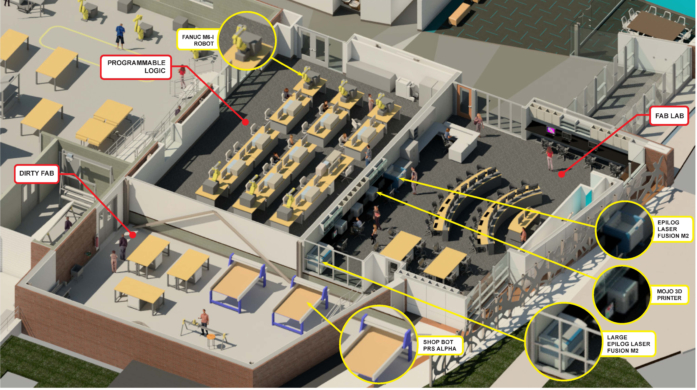Environments for Educating STEM

Everyone agrees that the acronym “STEM” is derived from “Science, Technology, Engineering, and Mathematics” and that it represents an interdisciplinary approach to project based learning. This is about where specific definitions begin to differ.
“Everybody who thinks they know what it means, knows what it means within their field, and everybody else is defining it to fit their own needs.”
It is clear that each educator and each institution has varying philosophies and strategies and that the concept is evolving continuously. Rather than presenting an undefinable vision for the designer of STEM (or STEAM, add “Art”) spaces, solutions can be driven by some broad and easy to implement goals. In fact, according to The Future of Jobs Report 2018 from the World Economic Forum, executives desire employees with critical thinking and collaboration skills more than those with tech skills. Careful planning for Environments designed for educating critical thinkers are warranted to prepare students with a competitive edge.
PROJECT BASED LEARNING: Applied to the sciences, this approach to learning abandons the “Sage on the Stage” and replaces them with a “Guide at the Side”. Project based learning requires doing and enough space to allow unhampered movement by learners who may be working alone or in teams. In any case, the process is messy and necessitates materials and partially completed projects to be worked on and often stored over some period of time. Resources such as water, waste, electricity, data, gas, and compressed air are standard needs – build for adaptability is the modern mantra. Furniture and room surfaces want to be durable, easily cleaned and resistant to mild chemicals. Solutions for storage of works in progress is also needed and, since the types of projects vary, their storage demands include everything from flat work to three dimensional and / or projects in containers. Display space for in-progress or completed projects is also a necessity.
FLEXIBLE: Whatever we think project-based learning represents this year, it will almost certainly be something different next year, or even with the next teacher in the same space. Therefore, the furniture and access to resources must be flexibly configured for partnering, small groups, or large groups. Fixed equipment and cabinetry should be kept at the perimeters, work tables and seating should be on casters for maximum flexibility and reconfiguration. Easily movable modules which can fit together in a variety of configurations is a start, augmented by power, data, and utility grids that can be accessed without creating tripping hazards. Arguably, the very process of “designing” the work space for any given project is one of the first steps in planning and accomplishing the project. Generally, large, square spaces lend themselves to being more flexible than most other shapes, but the concept is not limited. The ability to control both daylight and artificial light to the location of the work space and the needs of the project is important along with specific fresh-air exchanges, equipment ventilation specific to use of space, such as a laboratory versus a classroom. Taking action to support flexibility, furniture and fixture manufacturers have evolved their offerings to incorporate easily accessible parts bins at the benches and height adjustable work surfaces.
COLLABORATIVE: Part of the STEM model for most programs is creating teams who learn to collaborate to solve challenges through critical thinking and pragmatic application. A big part of the overall learning within a STEM space is the impromptu exposure to what various teams are doing and informal exchange of information by ideation. This requires open circulation within the space. This concept is often expanded to offer observation into the project space from general circulation outside of the space. Transparency has the impact of “merchandising” the activities taking place. In addition to the project space and resources, team discussion rooms with an abundance of writable wall surfaces and infused with a variety of audio, visual, and virtual reality technologies allow planning, discussion and group research. STEM learning is an iterative process, it is healthy to learn from mistakes and failures. These environments shall support learning beyond a core curriculum. Breakout areas with soft seating will encourage collaboration and sharing of ideas.
SPECIAL NEEDS: STEM learning can take place within specifically oriented programs. In addition to the general needs discussed above, special resources such as clean environments, lab hoods, dust collection, spray paint booths, 3-D printers, Multi-axis CNC machines, and scientific equipment may be part of the program needs from the very beginning. Even if they are not, there is a good chance that some collection of specialized equipment will find its way into a STEM space, largely based upon the programs being explored and those “Guides” leading the learning. Therefore, it is a good idea to leave some areas in strategic locations where this specialized equipment could be located. Planning for the eventuality of this requires some thought about how necessary utilities could be added and how the space would function with future equipment. Plenty of natural daylight is preferred paired with artificial LED lighting utilizing direct/indirect dimmable fixtures. Durable, cleanable finishes, such as polished concrete floors are important to these spaces. Providing a neutral backdrop with punches of color is desirable.
Regardless of how the space is oriented in the beginning or how it evolves through use, the overall goals of collaborative innovation, problem solving, ideation and active learning drive STEM Environments.



